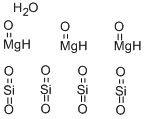Chemical Properties
White, apple-green, gray powder; pearly
or greasy luster, greasy feel. Mohs hardness 1–1.5
(may be harder when impure), high resistance to
acids, alkalies, and heat.
Uses
Chiefly as a ceramic insulator in electronic
devices.
Uses
Pigment in paint, varnishes; filler for
paper, rubber, soap; lubricating molds and
machinery; heat insulator.
Definition
A white or pale-green mineralform of magnesium silicate,Mg
3Si
4O
10(OH)
2, crystallizing in thetriclinic system. It forms as a secondarymineral by alteration of magnesium-rich olivines, pyroxenes, andamphiboles of ultrabasic rocks. It issoaplike to touch and very soft, havinga hardness of 1 on the Mohs’scale. Massive fine-grained talc isknown as soapstone or steatite. Talcin powdered form is used as a lubricant,as a filler in paper, paints, andrubber, and in cosmetics, ceramics,and French chalk. It occurs chie?y inthe USA, Russia, France, and Japan.
Definition
An extremely
soft greenish or white mineral, a hydrous
silicate of magnesium. Purified it is sold as
talcum powder, and it is used as a lubricant, a filler (in paint and rubber) and an
ingredient of some ceramics.
Definition
A natural hydrous magnesium silicate. Compact,
massive varieties may be called steatite in distinction
from the foliated varieties, which are called
talc. Soapstone is an impure variety of steatite.
Hazard
Toxic by inhalation. Effects pulmonary
function and causes pulmonary fibrosis. Questionable
carcinogen.
Health Hazard
The fibrous talc in soapstone
dust causes fibrotic pneumoconiosis; an increased
incidence of cancer of the lungs and
pleura has been reported.
Industrial uses
Steatites are noted for their excellent electricalproperties and low cost. They are easily formedand fired at relatively low temperatures. However,compositions containing little or no clayor plastic material present fabricating problemsbecause of a narrow firing range. Steatite partsare vacuum-tight, can be readily bonded toother materials, and can be glazed or ground tohigh-quality surfaces.


